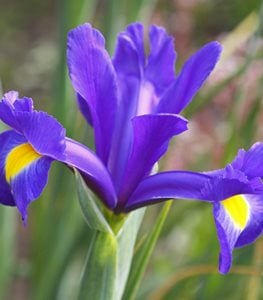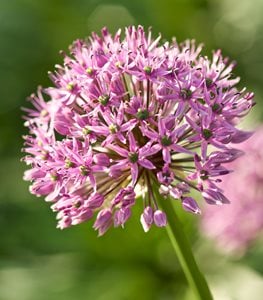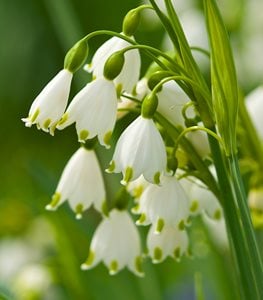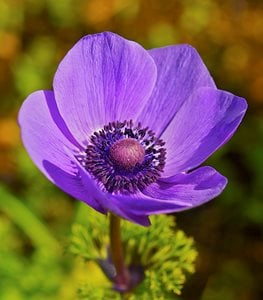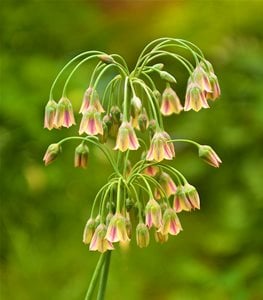20 SPRING-FLOWERING BULBS TO GROW
Try these reliable flower bulbs to plant in fall for spring colorFall is the time to plant bulbs that bloom the following spring. There’s a certain leap of faith in planting something that won’t come out of the ground for many months, but the anticipation of the first spring flowers helps stave off the winter blues.
There’s a wide selection of flower bulbs to plant in fall, from diminutive snowdrops to stately alliums. These bulbs can be planted in beds, borders, containers, or naturalized in woodland or native areas. Here are some of the best spring flowering bulbs and how to care for them.
On this page: Spring Bulbs | Tips for Buying, Planting, and Growing Spring Bulbs
On this page:
SPRING BULBS
TULIP (Tulipa spp.)
Zones: 3-8
Exposure: Full sun
Bloom time: Spring
Height/Spread: Upright habit; 3 to 24 inches tall, 3 to 6 inches wide
Uses: Plant tulip bulbs in beds, borders, containers, along pathways and foundations. Makes a good cut flower.
Tulips are one of the most recognized spring blooming flowers, with cup-shaped blooms in nearly every color except true blue. There are 100 species and thousands of cultivars, from dwarf forms to stately Darwin hybrids. This versatile bulb combines well with other spring blooming bulbs, early perennials and annuals. Mass in groups of 6 to 12 for the best effect.
Learn more about growing tulips.
DAFFODIL (Narcissus spp.)
Zones: 3-9
Exposure: Full sun to partial shade
Bloom time: Late winter to spring
Height/Spread: Upright habit; 4 to 24 inches tall, 2 to 3 inches wide, with clumps reaching up to 18 inches across.
Uses: Plant in mixed borders, rock gardens, or containers; naturalize in a woodland setting or natural area.
The cheerful trumpet-shaped flowers of daffodil are a sure sign of spring. There are hundreds of varieties in a wide array of sizes and forms, with colors of yellow, white, orange, peach, and bicolors. These reliable hardy bulbs are easy to grow and long-lived, providing many years of spring color in the landscape.
Learn more about growing daffodils.
HYACINTH (Hyacinthus orientalis)
Zones: 4-8
Exposure: Full sun to partial shade.
Bloom time: Spring
Height/Spread: Upright habit; 6 to 12 inches tall, 3 to 4 inches wide
Uses: Mass in borders and beds, grow in containers, force indoors in a bulb vase.
Hyacinth is one of the most intensely fragrant spring bulbs, with spiky clusters of star-shaped flowers. Blooms come in a rainbow of colors including blue, purple, red, pink, orange, coral, yellow, and white. This easy care bulb combines well with other spring bulbs that bloom at the same time, such as daffodils and early tulips. Plant where the sweet fragrance can be enjoyed up close.
Learn more about growing hyacinth flowers.
PERSIAN BUTTERCUP (Ranunculus asiaticus)
Zones: 8-11
Exposure: Full sun
Bloom time: Spring
Height/Spread: Upright spreading habit; 12 to 24 inches tall 4 to 6 inches wide
Uses: Plant in a cutting garden, bed, mixed border or container with good drainage.
This cool-weather plant is grown for the delicate ruffly flowers that are popular in floral arrangements and weddings bouquets. Rose-like blooms occur in a wide range of pastel or hot colors on sturdy stems, and are long-lasting as a cut flower. In colder zones, bulbs can be overwintered indoors in a cool dry place and planted outside in spring.
Learn more about growing ranunculus flowers.
IRIS (Iris spp.)
Zones: 3-9
Exposure: Full sun to partial shade
Bloom time: Spring to fall, depending on variety
Height/Spread: Upright spreading habit; 4 to 48 inches tall, 3 to 24 inches wide
Uses: Mass in beds, plant in mixed borders. Dwarf types can be planted in troughs or containers.
One of the most beloved spring bloomers is the elegant bearded iris (Iris germanica), with flowers in nearly every color and pattern imaginable. There are many other iris species as well, from early spring blooming dwarf iris (I. reticulata) to stately Japanese iris (I. ensata), which flowers in summer. Some irises rebloom in late summer or fall. Plants grow from rhizomes or bulbs.
Learn more about growing iris.
CROCUS (Crocus spp.)
Zones: 3-8
Exposure: Full sun to partial shade
Bloom time: Most varieties bloom in spring, though some bloom in fall
Height/Spread: Upright colonizing habit; 3 to 6 inches tall, 2 to 4 inches wide
Uses: Mass along a pathway or at the front of a border, plant in containers, naturalize in a woodland setting or underneath trees and shrubs.
The endearing blooms of crocus are one of the most highly anticipated sights in the early spring garden. This reliable perennial grown from small corms thrives in most zones and is easy to grow, even for beginner gardeners. Upright tubular flowers come in shades of white, pink, purple, blue, yellow, orange, bicolors, and patterns.
Learn more about growing crocus.
ALLIUM (Allium spp.)
Zones: 4-10
Exposure: Full sun
Bloom time: Spring, with some varieties blooming in summer
Height/Spread: Upright habit; 6 to 48 inches tall, 3 to 10 inches wide
Uses: Plant in borders, rock gardens, or containers to add height and architectural interest. Alliums are useful for filling in gaps and as long lasting cut flowers.
Ornamental alliums, which are related to their edible cousins, are grown for the attractive blooms. Spherical flower heads 1 to 12 inches across are comprised of tiny star-shaped florets that are highly attractive to bees and other insect pollinators. Blooms come in shades of purple, pink, blue, yellow, or white.
Learn more about growing alliums.
CYCLAMEN (Cyclamen spp.)
Zones: 4-9
Exposure: Partial to full shade
Bloom time: Fall to spring
Height/Spread: Upright mounding or spreading habit; 2 to 6 inches tall, 4 to 12 inches wide
Uses: Naturalize in a woodland setting; plant in a rock garden or container; combine with other early spring plants such as witch hazel, hellebores, and snowdrops.
This diminutive plant grown from tubers begins growing in fall, going dormant during warm summer months. Lightly scented flowers have elegant upswept petals in shades of white, pink or purple that complement the intricately patterned leaves. Species such as Persian violet (Cyclamen coum, pictured) and alpine cyclamen (C. alpinum) bloom from late winter into spring, adding early season color to the landscape.
Learn more about growing cyclamen.
FREESIA (Freesia spp.)
Zones: 9-10
Exposure: Full sun to partial shade
Bloom time: Spring and summer
Height/Spread: Upright habit; 12 to 24 inches tall, 3 to 6 inches wide
Uses: Grow in a garden bed, greenhouse or containers for cut flowers.
Sweetly perfumed clusters of tubular flowers in a range of colors are borne on long slender stems. This popular cutting flower is commonly used in wedding bouquets and floral arrangements. In frost-free regions, corms can be planted in the ground in fall for spring color. In colder areas, they can be grown in a greenhouse for winter flowers or planted outdoors in spring for summer blooming flowers.
Learn more about growing freesias.
SNOWDROPS (Galanthus spp.)
Zones: 3-8
Exposure: Full sun to partial shade
Bloom time: Early spring
Height/Spread: Upright spreading habit; 4 to 12 inches tall, 3 to 6 inches wide
Uses: Naturalize in a woodland setting, rock gardens, along pathways, and underneath deciduous trees and shrubs.
Snowdrops are among the first spring bulbs to flower, and are named for their appearance in February and March when snow is still on the ground. Tiny bell-shaped flowers borne singularly on slender stems are white, some with green markings. Common snowdrops (Galanthus nivalis) are grown most often. Bulbs can be short-lived in zones higher than 7. Plant in drifts for the best effect.
Learn more about growing snowdrops.
GRAPE HYACINTH (Muscari armeniacum)
Zones: 4-8
Exposure: Full sun to partial shade
Bloom time: Mid-spring
Height/Spread: Upright spreading habit; 6 to 9 inches tall, 3 to 6 inches wide
Uses: Naturalize in beds and borders, rock gardens, or woodland settings; mass along a pathway or slope; plant in troughs or containers; force for winter bloom.
Grape hyacinth is named for the tiny clusters of fragrant flowers that resemble grapes. The deep blue flower coloring is highly coveted, complementing many other spring blooming bulbs such as daffodils and tulips. Other Muscari species occur in shades of white, pink lavender, or yellow. Mass bulbs in groups of 25 or more for the best effect. Easy to grow, hardy, and reliable.
Learn more about growing grape hyacinth.
SIBERIAN SQUILL (Scilla siberica)
Zones: 2-8
Exposure: Full sun to partial shade
Bloom time: Early spring
Height/Spread: Upright spreading habit; 3 to 6 inches tall and wide
Uses: Naturalize in open woodlands, or underneath deciduous trees and shrubs. Use as a groundcover or combine with other early bulbs such as daffodils and species tulips.
This exceptionally hardy bulb, native to Siberia, Russia, and Eurasia, is one of the first to bloom in early spring. Brilliant blue bell-shaped flowers grow singularly on slender stems above the grass-like foliage. Bulbs multiply and naturalize quickly, and plants may also self sow. ‘Alba’ is a white flowered variety. Note: Siberian squill has been noted as being invasive in certain areas (see where).
FRITILLARIA (Fritillaria spp.)
Zones: 3-9
Exposure: Full sun to partial shade
Bloom time: Spring
Height/Spread: Upright spreading habit; 12 to 24 inches tall, 8 to 24 inches wide
Uses: Naturalize in woodland gardens, rockeries, and mixed borders; plant in troughs or containers.
The nodding bell-shaped flowers of Fritillaria add a unique touch to the spring garden. There are more than 100 species, ranging from the diminutive Michael’s flower (Fritillaria michailovskyi) to the bold upright stands of crown imperial (F. imperialis, pictured). Flowers occur in colors of white, yellow, chocolate, orange, red, and purple, some with patterns or bicolors. This underutilized bulb deserves wider use in the landscape.
Learn more about growing fritillaria.
SPANISH BLUEBELLS (Hyacinthoides hispanica)
Zones: 3-8
Exposure: Full sun to partial shade
Bloom time: Mid-spring
Height/Spread: Upright spreading habit; 8 to 18 inches tall, 8 to 12 inches wide
Uses: Naturalize in woodland settings, beds and borders, underneath deciduous trees and shrubs.
Spanish bluebells are especially lovely in open woodland settings, with clusters of bell-shaped flowers on robust stems surrounded by lush, strappy foliage. The most common forms are vivid blue, though other colors include white and pink. Plants multiply, naturalize, and self-sow vigorously, becoming invasive in some regions (see where). Tolerant of varying soil and light conditions.
WINTER ACONITE (Eranthis hyemalis)
Zones: 4-7
Exposure: Full sun to partial shade
Bloom time: Late winter to early spring
Height/Spread: Low spreading habit; 3 to 6 inches tall and wide
Uses: Plant underneath winter blooming shrubs such as witch hazel or viburnum. Naturalize in woodland settings, borders, rock gardens, and lawns.
This early blooming groundcover bursts from the ground in late winter or early spring, even before the first crocus. Cheerful yellow buttercup-like flowers are surrounded by a collar of divided leaf bracts, with dark green foliage emerging after the flowers fade. Winter aconite spreads readily, combining well with other early bloomers such as snowdrop, species crocus, and hellebores. Mass in the landscape for the greatest impact.
GLORY OF THE SNOW (Chionodoxa spp.)
Zones: 3-8
Exposure: Full sun to partial shade
Bloom time: Early spring
Height/Spread: Low spreading habit; 3 to 10 inches tall and 1 to 6 inches wide
Uses: Mass underneath trees and shrubs, in a woodland or rock garden. Choose a spot where the small blooms can be appreciated up close.
Glory of the snow is one of the earliest bulbs to flower and is named for its ability to poke out from underneath the cover of snow. Clusters of star shaped upward-facing flowers occur in colors of blue, pink, or white. Plants are exceptionally hardy, naturalize readily, and can be grown in most regions.
SUMMER SNOWFLAKE (Leucojum aestivum)
Zones: 4-8
Exposure: Full sun to partial shade
Bloom time: Mid-spring
Height/Spread: Upright habit; 12 to 24 inches tall, 2 to 3 inches wide, with clumps reaching 8 to 12 inches wide
Uses: Naturalize in woodland gardens, mixed borders, and along streamsides and ponds.
Charming bell-shaped flowers grow on stately stems above grass-like foliage. Flower petals are white with green spotted tips. Contrary to the common name, this bulb blooms in spring, going dormant in summer. ‘Gravetye Giant’ is a common variety with larger flowers. Mass in groups of at least 6 to 12 for the greatest impact. Clumps will multiply and naturalize.
ANEMONE (Anemone spp.)
Zones: 5-10, depending on type
Exposure: Full sun to partial shade
Bloom time: Spring
Height/Spread: Upright spreading habit; 4 to 14 inches tall, 4 to 9 inches wide
Uses: Naturalize in woodland or natural sites, in open areas or underneath deciduous trees and shrubs.
Anemone is an herbaceous perennial or bulb that blooms in different seasons, depending on the species. Poppy anemone (Anemone coronaria, pictured) is a spring bloomer grown from bulbs, hardy in zones 7-10. Poppy-like flowers occur in colors of red, purple, blue, or white. Grecian windflower (A. blanda), a spring blooming groundcover grown from rhizomes, is hardy in zones 5-8. Daisy-like flowers are purple, blue, pink, or white.
Learn more about growing different types of anemone.
CAMAS LILY (Camassia spp.)
Zones: 9-11
Exposure: Full sun to partial shade
Bloom time: Mid-spring to early summer
Height/Spread: Upright spreading habit; 1 to 4 feet tall, 1 to 2 feet wide
Uses: Naturalize in meadows or open woodlands; plant in mixed borders.
The elegant flower spikes of camas lily produce clusters of star-shaped flowers in colors of blue, purple, or white. A member of the lily family, the bulbs of this North American native were an important food source for indigenous tribes and early explorers. Bulbs are cold hardy, long-lived, and naturalize well. Mass in drifts for the greatest impact.
SICILIAN HONEY GARLIC (Nectaroscordum siculum)
Zones: 4-8
Exposure: Full sun to partial shade
Bloom time: Late spring
Height/Spread: Upright habit; 32 to 38 inches tall and 3 to 6 inches wide
Uses: Plant in beds, borders, or cottage gardens; combine with other spring blooming bulbs or perennials.
Also known as Mediterranean bells, this Allium relative produces clusters of bell-shaped flowers on arching stems that resemble fireworks. Flowers are a muted purple-pink tinged with green. Plants have a strong garlic scent when bruised, hence the common name. This long-lived perennial bulb is reliable, low maintenance, and disease-free. Mass in groups of 5 to 7 for the best visual impact.
Looking for unique bulb varieties? Check out these 18 Stunning Bulbs to Plant in Fall
BUYING, PLANTING, AND GROWING SPRING FLOWERING BULBS
When to buy spring blooming bulbs:
Bulbs are available for sale through online sources and garden centers from late summer to mid fall. Buy early for the best selection. Garden centers carry potted bulbs in spring, though selection is limited.
How to choose good bulbs:
Choose bulbs that are large and firm. Avoid bulbs that are mushy, moldy, shrunken, or cracked.
When to plant spring bulbs:
In colder climates (USDA Zones 1-4), plant bulbs in September or October before the first hard frost. For warmer regions (Zones 5-8), wait until the weather has cooled off to plant in October or early November. In zones 9-11, treat bulbs as annuals. Pre-chill bulbs for 12 to 16 weeks and plant in spring.
Where to plant spring bulbs:
Choose a site that has the proper conditions for each variety, taking into consideration light, temperature, and soil.
How to plant spring bulbs:
- Amend the planting area with compost or other organic matter, making sure there is adequate drainage to prevent bulb rot. For containers, use a high quality all-purpose potting mix.
- Plant bulbs at the proper depth, 2 to 3 times deeper than the bulb diameter. Place with the pointed side up and the root side down. Space smaller bulbs 3 to 4 inches apart; larger bulbs can be spaced 4 to 6 inches apart. Bulbs in containers may be grouped closer together. Plant in clumps of 6 to 12 or more for the greatest impact.
- In areas where rodents are a problem, bulbs may need to be protected with wire mesh or other deterrent.
Fertilizing spring bulbs:
At the time of planting, apply a slow-release granular fertilizer formulated for bulbs according to package instructions. This will help roots become established before winter sets in. Reapply annually on the surface of the soil around plants when they begin showing spring growth.
Watering spring bulbs:
Water deeply after planting and again before the ground freezes. When bulbs first show growth in spring, resume watering once a week or so if there hasn’t been measurable rain. Avoid overwatering to prevent bulb rot. Bulbs planted in containers dry out more quickly, so will need to be watered more often. Keep soil moist until bulbs die back completely.
Care after blooming:
When plants are finished flowering, allow the foliage to die back naturally, which allows energy to be stored in the bulb for the next year’s growth. Plant bulbs alongside perennials such as hosta that will grow up to hide the unsightly bulb foliage. Clean up spent foliage once it’s turned completely brown.
Dividing:
Bulbs may become overcrowded, which can inhibit flowering. Divide every few years as needed. Once bulbs go dormant, they can be dug up, divided and replanted with proper spacing.
RELATED:
Bulbs 101: How & When to Plant Bulbs
7 Tips for Beautiful Bulb Garden Design
Popular Flower Bulbs




